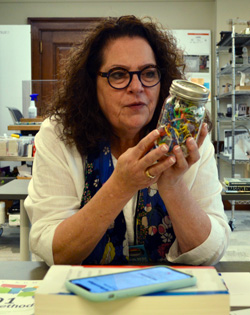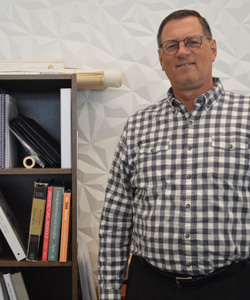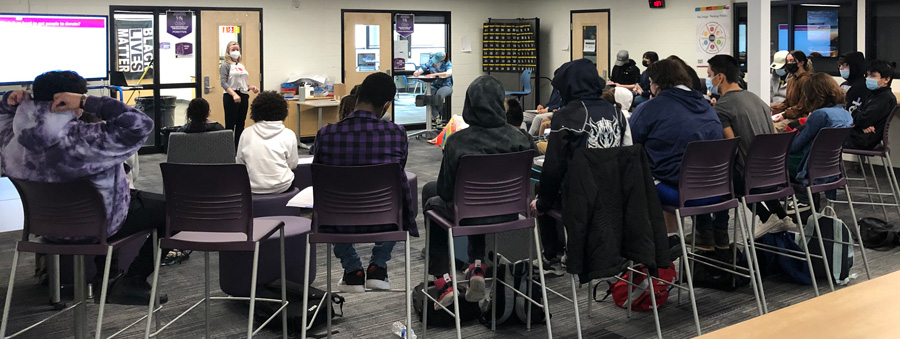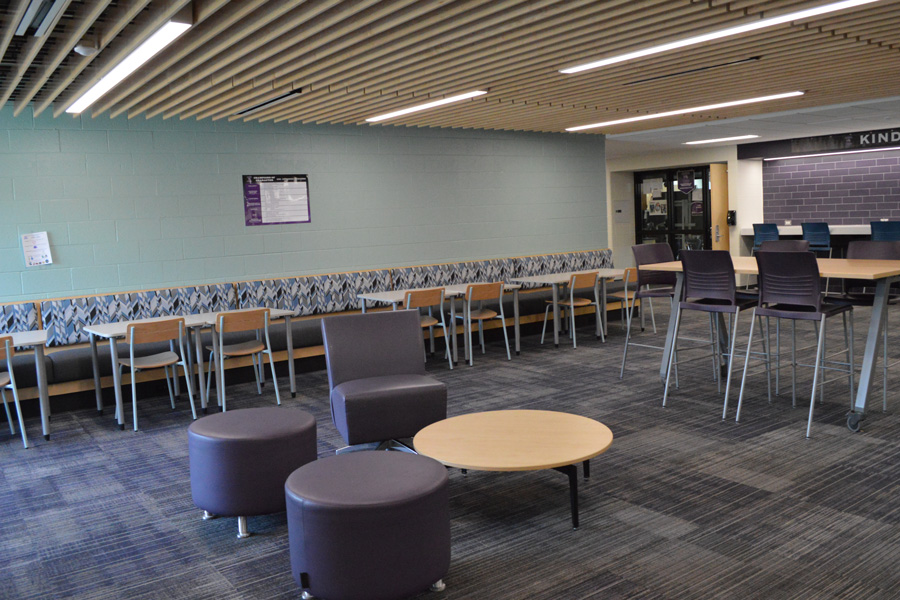EDITOR’S NOTE: This is the first in a four-part series about how school districts in Kent County are part of a national trend of making the design of schools and classrooms an integral and intentional part of the teaching process. School News Network examines the architecture of new buildings, the creative adaptations of older ones and the issues of equity involved in enhancing school spaces — also known as the ‘third teacher’ for their influence on student learning.
Multiple districts — Inside a newly built art room at Wyoming High School, complete with new tables, chairs and technology, students sketched while considering the school’s spaces they like to learn in.
“I like the breakout rooms because I can go in a space with one other person and have quiet,” junior Isabelle Castro said of the office-like spaces incorporated into the hallways.
In a nearby common area, senior Amillion O’Neal animatedly discussed a graphic novel with a classmate while sitting on comfy chairs. Fellow students walked by on their way to class and lunch while a group worked on a project in a breakout room.
Then there are the Learning Stairs — a tier of wide, carpeted steps where students can gather to work or socialize. “I like the Learning Stairs and breakout rooms,” Amillion said of the new high school building, designed by GMB Architecture + Engineering, with construction led by The Christman Company. “I get on my computer and do my work.”
New learning spaces as ‘The Third Teacher’: an SNN archive
• Room to learn and grow at Byron Center High School
• New dual immersion school in Grand Rapids is an impressive investment in students and community

These students are experiencing and describing the power of the physical learning environment, which educators increasingly regard as an important factor in how students learn.
Proponents say the environment is anything but a mere backdrop for learning; from spaces to furnishings to natural light, the physical world is a teacher, too. According to “The Third Teacher,” a book that explores the educational impact of instructional space, it comes right after adults and other youth as an influence on learning.
Gayle DeBruyn, a professor of Collaborative Design and sustainability officer for Kendall College of Art and Design of Ferris State University, defines the third teacher this way: “It’s all that you surround yourself with to support the work that you are doing” with students.
Wyoming High School is a prime example of how many Kent County districts are addressing this key element of learning: from allocating bond funds for major construction projects; to using general funds to create flexible learning environments; to reconfiguring existing spaces. Michigan has even earmarked funds for a statewide capital improvement study to assess school buildings.
Form Follows Function
Redesigning spaces for today’s learning often aims to minimize the traditional mode of whole-group, lecture-style teaching. An emphasis on creating new knowledge over consuming information has, in part, driven the interest in the concept of environment as the third teacher.
The factory model of education, where students move passively through a system that sorts and selects their opportunities based heavily on test scores, was the norm throughout much of the last century. The form of school, its spaces and schedules followed the function it was intended to fill: to train students of the same age at the same rate and in the same way for jobs that were plentiful in a postwar economy.
‘I like the breakout rooms because I can go in a space with one other person and have quiet.’
— Isabelle Castro, Wyoming High School junior
A sense of belonging wasn’t necessarily paramount. Rather, school was about learning a body of knowledge that served an industrial economy well. It didn’t necessarily result in people working cooperatively together to create new knowledge or gain proficiency in broad, transferable skills like collaboration and creative innovation — outcomes widely considered essential today.

Steve Hoekzema, principal and director of K-12 education at TowerPinkster, a Grand Rapids architecture, engineering, and interior design firm, understands the reactions of students to these new spaces such as Wyoming’s.
Throughout his three-decade career, he has worked on building projects in 75% of Kent County’s public school districts and in 72 Michigan public schools. He has been a part of projects including Byron Center’s Countryside Elementary, Grand Rapids’ City High/Middle School and Northview High School.
Hoekzema notes that “learning environments must be human scale, be welcoming and provide physical comfort … and a sense of well-being.”
He contrasts the experience of the Wyoming High School students with his own at Grand Rapids Christian High School. During the 1950s and 1960s, the goal of school construction nationwide was to accommodate a million new students per year in an efficient way. This resulted in schools with long corridors and uniformly sized spaces, a structure he dubs “cells and bells.” Working together, he said, was called “cheating.”
Today, collaboration is considered a key skill for students both in school and in post-high school education and the workplace, he points out. Researchers such as the authors of “Becoming Brilliant: What Science Tells Us about Raising Successful Children” agree, calling the highest level of collaboration “building it together.”

Focus on Transferable Skills
Kent ISD Superintendent Ron Koehler notes that county-wide discussions about the need for teaching broad, transferable skills led to the development of new kinds of learning spaces in recent years.
“The architects who work on these projects also are aware of these skills as they ask the questions in communities where building projects are developed,” Koehler said. “(They) listen to student voice and bring these insights to new projects.”
He recalls that district leaders asked Kent ISD more than a decade ago to provide a new model so districts could see how redesigned learning spaces and curriculum could create more meaningful learning. Kent Innovation High School was a 2009 prototype that eventually led to new designs in districts themselves.
‘We didn’t want to be stuck in a standard classroom because the things that we do in here are very collaborative.’
— Jon Bushen, Wyoming High School teacher
Just as the factory model of education mirrored the workplace of an earlier day, today’s pre-k-12 learning spaces should “look more college and workplace-like” so that students can envision themselves in them one day and say “Hey, I belong here,” Koehler added.
Transitioning to new ways of learning in more student-centered spaces can be unsettling for some. Kendall’s DeBruyn, who also was a co-developer of Grand Rapids Public Museum School, says more needs to be done to unlearn old methods and relearn new approaches: “Projects are big in real life. They don’t get solved in 15 weeks.”
Thumbs Up to Spinning Chairs
Students have enjoyed the chance to learn in the student-centered spaces of the two-story, 30-classroom Wyoming High School building since it opened in 2020.
Principal Josh Baumbach said he sees students taking advantage of the building’s features in many ways: working together in groups, watching videos related to projects, and enjoying independence similar to that of a college environment.
Teachers use open space as non-traditional classrooms, constantly rearranging furniture and encouraging group work and dialogue. A peer-to-peer class, in which general education and special education students work together, also makes use of the openness.
‘Learning environments must be human scale, be welcoming and provide physical comfort … and a sense of well-being.’
— Steve Hoekzema, architect at TowerPinkster
There are ample places to sit and study such as the Learning Stairs, booths, cushions and office-style seats. Quiet rooms are equipped with technology for group work. The special features are popular with students.
“I like the spinning chairs because I like to move,” said junior Amerika Wells about the style of chairs found in many areas.
“I like how we can work outside of the classroom and not always be in the classroom,” said junior Izaylah Bracy.
Teachers Jon Bushen and Logan Klepac use a completely open area for the problem-solving innovation course they teach as a team.
“We didn’t want to be stuck in a standard classroom because the things that we do in here are very collaborative,” Bushen said.
“Our kids can get up and move, so at times this will be a normal setup with kids sitting at high and low tables. But this is all movable furniture, so if we have a guest speaker we will pull the tables back and make an auditorium out of it, with the speaker in the front.”
They also often reconfigure into circles, encouraging lots of discussion.
“The flexible space allows us to teach in a variety of ways,” Bushen said. “We don’t really want to teach in lecture style much anymore, so it’s more of trying to adjust as a collaborative facilitator and letting the kids grow their mindset so they work together.”
Erin Albanese contributed to this story
Next installment: Not all districts have the resources to construct new buildings or additions, but some teachers have redesigned traditional classrooms to enhance their students’ learning.














